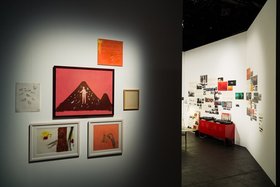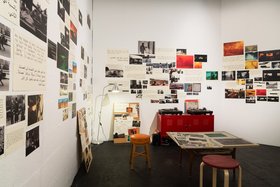Reviews
Points of Departure
Institute of Contemporary Art, London
Points of Departure (26 June 2013 – 21 July 2013) was that exceptionally rare thing: an exhibition – with talks and screenings but no bibliographic supports – of visual art works by Palestinian artists and works responding to Palestine by British artists taking place within a major British institution: the ICA. This is a cause for celebration, however belated, and necessarily without consequence in terms of the work itself.
The exhibition was held in the ICA's theatre and curated by Rebecca Heald and Mirna Bamieh, with multiple partners including Delfina Foundation and ArtSchool Palestine. It was one of the Shubbak Festival 2013's main events and involved British artists spending time in Palestine and Palestinian artists doing the same in London. This over-layering is one of the elements in a rather clunky curatorial emphasis on liminality: that threshold zone arrayed with points of departure.
I last entered the ICA's theatre during Shubbak 2011 when Emily Jacir spoke with passionate precision about art teaching in Palestine. Jacir's work pioneered the mining of a rich seam of Palestinian cultural history through word and image so as to find forms for the present state of existence. The former has involved substantive recovery and re-archiving amongst materials bequeathed by the Nakba and with the abysmally personal effects of unacknowledged victims.
I'm thinking of Material for a Film (2006-onwards), in particular, which represented the life and assassination of Wael Zuaiter in 1972, first – but far from last – of the intellectuals, writers and political figures hunted down by the state of Israel. Jacir's startlingly affective work recognised an erased past and remade it in the present. The work is also an enabling influence on Basel Abbas and Ruanne Abou-Rahme's brilliantly achieved archival installation and film: The Incidental Insurgents (2012-13).
Jacir's contrapuntal condensations also made me wonder whether the popular trope of liminality goes very far in engaging the actual experience of Palestinians in Nablus, Rafah or forcibly scattered across the world. The latter question is important because while many of us appreciate a global restructuring that is in train, replete with fissures and points of departure, Palestine remains imprisoned and besieged in the Modern. I use the term theoretically and with common reference to a racially exclusive nineteenth century ideology that has generated such monstrous effects and unending catastrophe. If it is boring to be so anchored in the actual, it does also allow me to celebrate Abbas and Abou-Rahme's work for the same reasons.
The Incidental Insurgents is partly a bandit's lair, resistance cell, and artist's studio of archival retrievals from Victor Serge, Abu Jildeh's anti-colonial bandits and Robert Bolano's orphan rebels in The Savage Detective. Walls swarm with imagery and quotation, above desks with Bande á Part looping on screen beside stacks of DVDs and books, files, post-its, and a whole paraphernalia of making. It is a well-judged investigation into rebellious pasts as well as forms and histories of resistance, especially where art-making and political change overlap.
Abbas and Abou-Rahme's assemblage is familiar as a form but distinguished by its birth within – and 'escape' from – a uniquely chronic Occupation. While it is possible to depart and even return, theirs is a perilous existence. Beyond that, this is an archival work dedicated to future language and poetic acts -as demonstrated by their six-minute video, which is also part of this show. It manages to condense these questions again with visceral force but also condense forms in a video embracing commercial film languages while quoting from the textual maps taped all over neighbouring walls.
Of the British artists, Jeremy Hutchison contributed a wry one-liner with unusable jeans designed to reflect working life in Nablus. Olivia Plender showed a pair of videos and empty museum vitrines, which express – or perhaps internalise – the overwhelming difficulty of responding to the actuality of Palestine. One video 'shows' a collection of amulets in brief glimpses between long reversions to black.
Palestinian artists Bashar Alhroub and Bisan Abu-Eisheh made mild-mannered attempts at rendering a barely graspable identity in London and Jerusalem. Jumana Emil Abboud installed two sets of images in paint and pencil as well as a notably precise video called I Feel Nothing (2012-13), all of which pursue an intriguing vein of obscurantism made entirely respectable by Mahmoud Darwish and Edouard Glissant. As ever with Abboud's work, it left me with the perfect ambivalence of wanting to see more.
The Incidental Insurgents lent Points of Departure significant ballast. Here, we have two artists born in 1983 posing the right questions and attempting answers in works of striking reach and command. Resident in Ramallah they are becoming artists of global stature, making work that exceeds dubious curatorial thematics and institutional permissions. A fitting point of departure would be for the ICA to invite them to fill the building with a solo show.


















